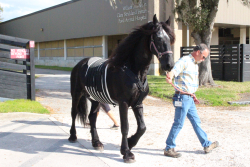Stallion with rare form of colic survives after surgery at UF

Morriston resident Valerie Frederick still is haunted by the loss of a beloved Friesian colt that succumbed to colic several years ago. So when her second Friesian, a 20-year-old stallion named Hannibal, began showing signs of the illness, she knew she would do everything possible to save his life.
On the advice of her veterinarian, Alfredo Lichoa, D.V.M., she brought Hannibal to the University of Florida Large Animal Hospital on Jan. 13. Through tests that included gastroscopy and abdominal ultrasound, a team of specialists diagnosed a rare gastric impaction with severe chronic gastric dilation — a condition in which feed material is trapped in the stomach, leading to distention. After a week of intensive medical management failed to empty Hannibal’s stomach, Todd Holbrook, D.V.M, D.A.C.V.I.M., a clinical professor in the UF College of Veterinary Medicine and one of the equine medicine specialists who treated Hannibal, recommended surgery.
He contacted his fellow faculty member, David Freeman, M.V.B., Ph.D., D.A.C.V.S., a professor of equine surgery at UF who holds the Appleton Endowed Professorship and is renowned for his expertise in colic surgery, to discuss the case. On Jan. 27, Freeman successfully operated to remove Hannibal’s impaction, using a technique he developed at UF and has only used a handful of times due to its difficulty.
“In my 30 years as an internist, in similar cases, I was not able to offer surgical options,” said Holbrook, who joined UF’s faculty in 2021.
The procedure took approximately four hours to complete.
“Unfortunately, there’s really no good medical treatment for this condition,” Freeman said. “Relative to their size, horses have a very small stomach. Because it’s so small, it is not easy to reach during surgery. When the stomach is impacted, it’s very full and heavy, and you can’t lift it out of the abdomen at all.”
The technique Freeman developed for this type of surgery improves surgical access to the equine stomach and involves an incision that goes over the stomach, under the diaphragm and ribs and then curves forward, in a shape similar to the letter “J.”
“We have rarely used this procedure, but we did know going in that we were going to do it,” Freeman said. “We recognized that it was a gastric impaction, which is always difficult to treat surgically. Some would not attempt it.”
Fortunately, Hannibal recuperated well from the procedure. He remained hospitalized as Holbrook and his team kept him stabilized.
“He was initially held off feed and given partial nutritional support intravenously for several days,” Holbrook said. “Subsequently, we began feeding a small amount of a complete feed mixed with water to a slurry consistency, and over the next week, we gradually increased the feeding frequency from every four hours to every two hours while simultaneously gradually increasing his intake toward his caloric needs and eventually weaning him off of IV nutrition.”

“He’ll be able to come and go with a muzzle on to walk around, and won’t be able to graze—though I’m sure he’ll try,” said Frederick, who described Hannibal as her “absolute joy.”
The Friesian breed is popular in Europe and the United States as a riding horse because of its pleasant disposition, its uniformly black coat, large size, thick mane and tail, and statuesque appearance.
Before surgery was performed, Frederick had read up on Freeman’s expertise, and said she initially was “just a wreck,” hoping things would go well.
“I kind of knew in my heart that everything would be OK, but when they finished the surgery and said it went well, things just kept going better and better,” Frederick said. “I told the doctors there, do what you have to do to save him,” Frederick said. “And they did.”
As board-certified veterinary specialists in internal medicine and surgery, respectively, both Holbrook and Freeman have completed additional training in their specific areas of veterinary medicine and have passed an examination in their chosen specialty.
Media contact: Sarah Carey, careysk@ufl.edu, 352-294-4242
About the author
